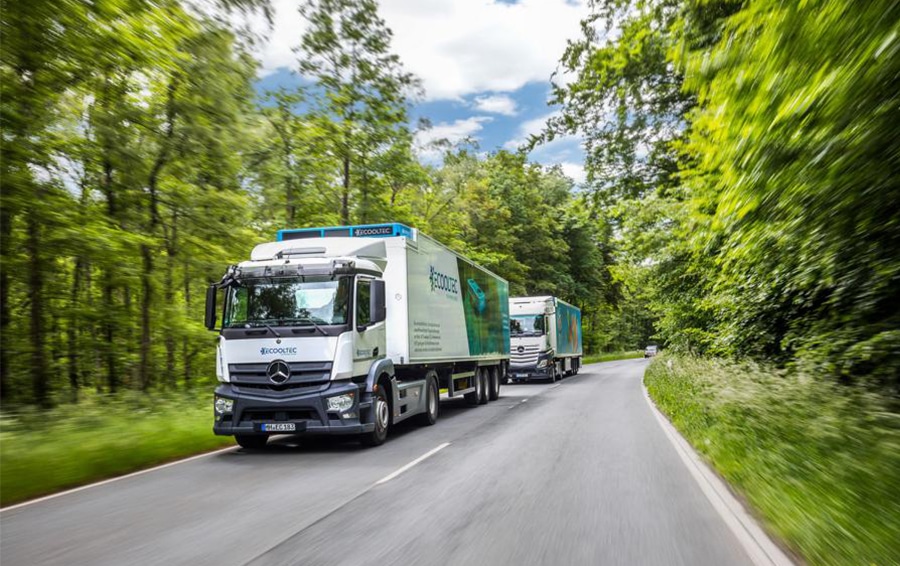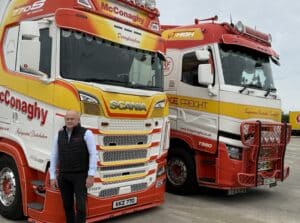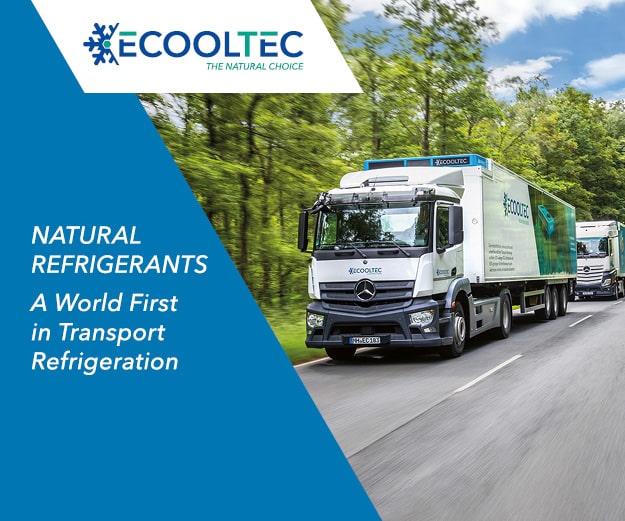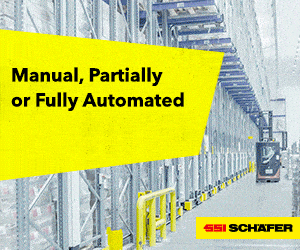The fluorinated refrigerants still being used in new transport refrigeration systems are slowing down progress in the reduction of greenhouse gases in temperature-controlled freight transport. ECOOLTEC has proven that the use of natural refrigerants in transport refrigeration units is not only possible but is available today, and that these refrigerants have no impact on the environment or climate. In addition, long term availability is guaranteed; natural refrigerants also offer clear advantages in terms of operational safety, operating costs, and specific refrigeration capacity.
By 2030, according to the Green Deal, all EU member states must reduce greenhouse gas emissions by at least 55 percent compared to 1990 levels and even be climate neutral by 2050 at the latest. The so-called F-Gas Regulation (EU) 517/2014 also requires the industrial sector to reduce greenhouse gas emissions by more than 70 percent before 2030 when compared to 1990 levels. This is currently being revised, and a further acceleration of the measures is to be expected. Even today, these challenging targets have an impact on refrigeration in temperature-controlled road transport. Up until today, almost all transport refrigeration systems still operate with fluorinated refrigerants, so-called F-gases, most of which have a high greenhouse gas potential or Global Warming Potential (GWP) and whose presence in the atmosphere is also responsible for the formation of environmentally harmful substances such as trifluoroacetic acid (TFA) and perfluoroalkoxy polymers (PFA).
However, all operators of heavy refrigerated vehicles now have the possibility to achieve an F-gas-free supply chain. ECOOLTEC Grosskopf GmbH are proud to offer a transport refrigeration system that uses state of the art, environmentally friendly technologies and exclusively uses sustainable and future-proof natural refrigerants with the lowest, single-digit GWP values.
Common refrigerants R452A and R410A increase greenhouse effect
However, new transport refrigeration systems for heavy commercial vehicles, that correspond to conventional technology, mostly use R452A and R410A with GWP values of more than 2,000, i.e., have a CO2 equivalent of more than 2,000. When these refrigerants leak, they increase the greenhouse effect enormously. To reduce the negative impact of F-gases on the climate, the European Union has adopted the F-Gas Regulation.
The REACH Regulation (EC) 1907/2006 aims to limit the use of chemicals with harmful effects on human health. In the future, this legislation could also be applied to F-gases, if so, that would have a strong restrictive effect on the use of refrigerants, especially those forming TFA and PFA.
Open and semi-hermetic refrigeration systems steadily emit refrigerants
Since current transport refrigeration systems usually do not have a fully hermetic refrigerant circuit, refrigerant leaks steadily over time. According to studies, the leakage rate for such systems is at least ten percent per year and can be significantly higher, depending on the design and use of the machine. The total refrigerant charge in typical systems for heavy-duty commercial vehicles is up to 18 kilogrammes, depending on the model and design. In this case, an average of around 1.8 kilogrammes of F-gases per vehicle are released into the atmosphere every year. Depending on the refrigerant, this corresponds to a CO2 equivalent of around 3.8 tonnes per year per unit. Extrapolated to the entire fleet of refrigerated vehicles with a gross vehicle weight of more than 12 tonnes in Germany alone is around 53,000 units, this results in greenhouse gas emissions of around 200,000 tonnes of CO2 equivalent.
Due to the high GWP values of hydrofluorocarbons, the F-Gas Regulation has restricted the use of new F-gases with a particularly high global warming potential of more than 2,500 since January 2020, if the refrigerant charge in relation to the CO2 equivalent exceeds five tonnes. In addition, the regulation stipulates that the industry may only place fluorinated refrigerants on the market in limited quantities (phase-down). The higher the GWP value of an F-gas, the lower its availability will be over the coming years. The resulting shortage of common refrigerants makes those with high GWP values more expensive. As a result, the prices for synthetic refrigerants have risen sharply since the introduction of the regulation and even increased tenfold at the peak. In individual EU countries, fluorocarbons are also made more expensive by various tax models.
Bans on F-gases endanger the operational safety of refrigeration systems
At the same time, bans on F-gases jeopardise the operational life of refrigeration systems if suitable refrigerants are no longer available for servicing. Also, the use of refrigerants with similar properties during refrigeration, but lower GWP, is usually not possible without costly technical adjustments to existing systems. Furthermore, the F-Gas Regulation requires regular leakage tests for all refrigeration systems, whereby the number of required assessments depends on the CO2 equivalent of the refrigerant and the quantity of the refrigerant charge. Common transport refrigeration systems accordingly require an annual inspection, which is associated with significant costs.
These uncertainties and costs can be avoided by specifying ECOOLTEC’s innovative transport refrigeration units. The use of natural refrigerants provides even more advantages for users. Hydrocarbons are characterised by a high energy efficiency of the refrigeration process and offer good availability at a competitive price. In addition, ECOOLTEC has reduced the refrigerant charge by 90 percent compared to comparable conventional systems to less than 1.5 kilograms of propene distributed over two external circuits in two refrigeration chambers.
Fully hermetic design ensures maximum safety
At the same time, ECOOLTEC has focused on maximum operational safety. The natural refrigerant R1270 (propene, GWP: 2) used for refrigeration circulates in a fully hermetic circuit, and the refrigeration process takes place completely outside the cargo hold. There, the natural, constantly present air flow ensures that the R1270 refrigerant evaporates immediately in the unlikely event of a leak. In the box body, the ECOOLTEC transport refrigeration system uses only CO2 (GWP: 1) for cold distribution.
The R1270 and CO2 circuits flow past each other outside the body via a plate heat exchanger and are thus thermally linked. “Those who specify a system from ECOOLTEC not only actively contribute to climate and environmental protection, but also benefit economically. Fleet operators will avoid the expected shortages and increases in the price of F-gases while at the same time helping to guarantee the future operational reliability of their system. Moreover, the operating costs are significantly lower than those of conventional systems, among other things due to the reduced need for service,” explains Dr Jürgen Süß, CTO of ECOOLTEC.
ECOOLTEC system protects the climate and enables CO2 neutrality
In addition, the ECOOLTEC system contributes to decarbonisation and thus to the efforts of many working to achieve CO2 neutrality in road freight transport. This makes it an important instrument in assisting the EU to achieve its ambitious climate targets in a number of ways. As it is fully electric, it can always be operated in an energy-efficient and low-emission manner either via the in-house high- performance generator on the truck engine, a locally emission-free energy source such as a battery or a land-based power cable, and therefore does not need its own integrated diesel engine. Consequently, the ECOOLTEC system produces no harmful direct engine pollutant or CO2 emissions. The engines used to power conventional transport refrigeration systems are not subject to automotive exhaust emission regulations such as the Euro 6 standard, although the same engines have for some considerable time been offered with common rail injection and exhaust gas after treatment in the marine engine sector. They are therefore normally operated without exhaust gas purification. “Of course, the perfect solution from an environmental perspective is to combine our refrigeration system with a locally emission-free, all-electric drive. In this case, due to the high efficiency of the ECOOLTEC system, we can additionally ensure that compared to other systems in the market, the range of an electrically driven refrigerated vehicle is increased by using such a state of the art refrigeration system,” says CTO Dr Jürgen Süß.
The ECOOLTEC TM182 can be mounted on semi-trailers and rigid vehicle bodies. Its enormous performance makes it suitable for even the most demanding applications with high load volumes and lowest internal insulated body temperatures as well as easily coping with a high number of door openings. It offers the highest temperature safety and shortest pull-down times under all conditions. Its energy consumption is nevertheless remarkably low due to the high efficiency of the refrigeration process. The system uses 60 to 80 percent less energy than many diesel-powered, commercially available systems with the same cooling capacity.













